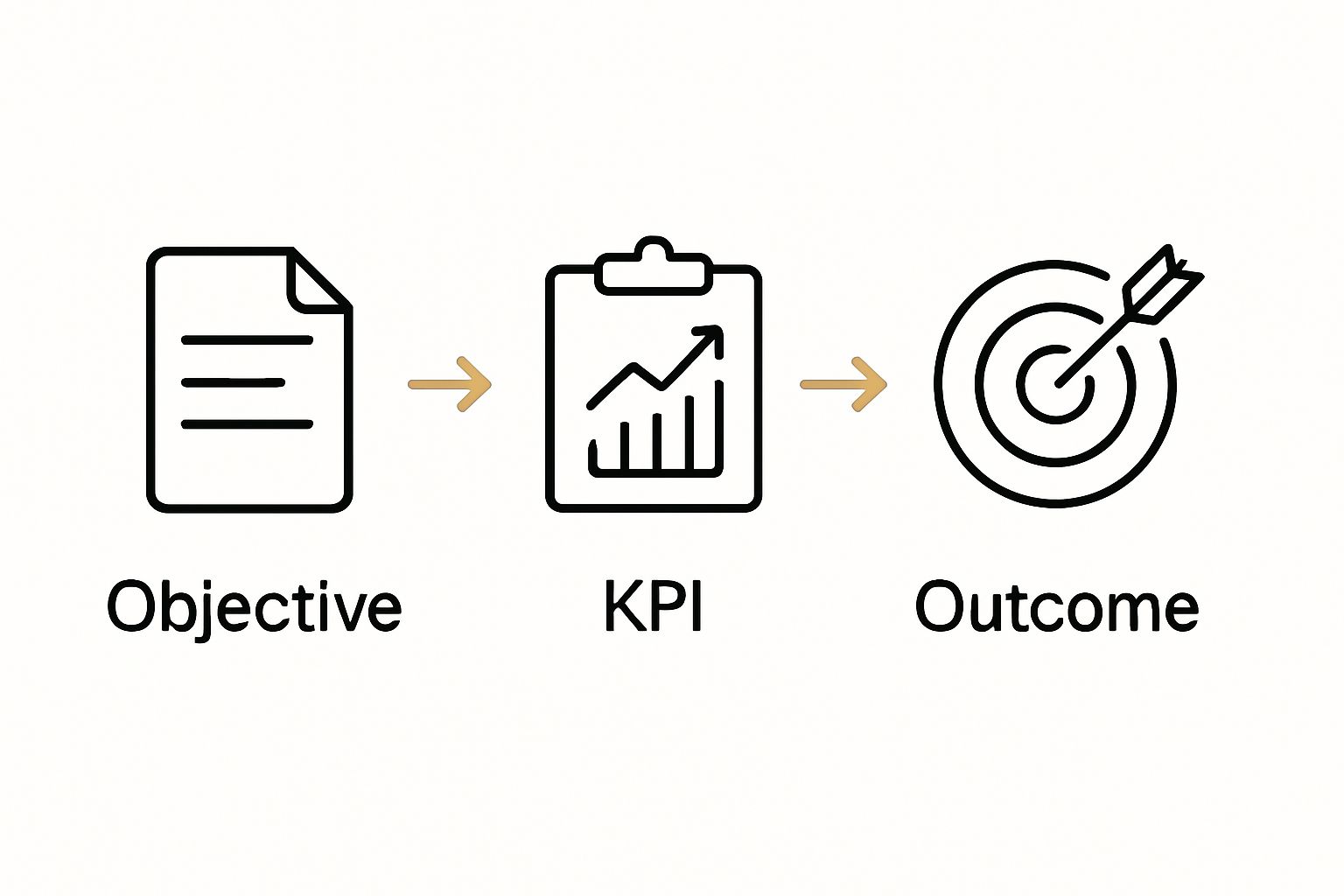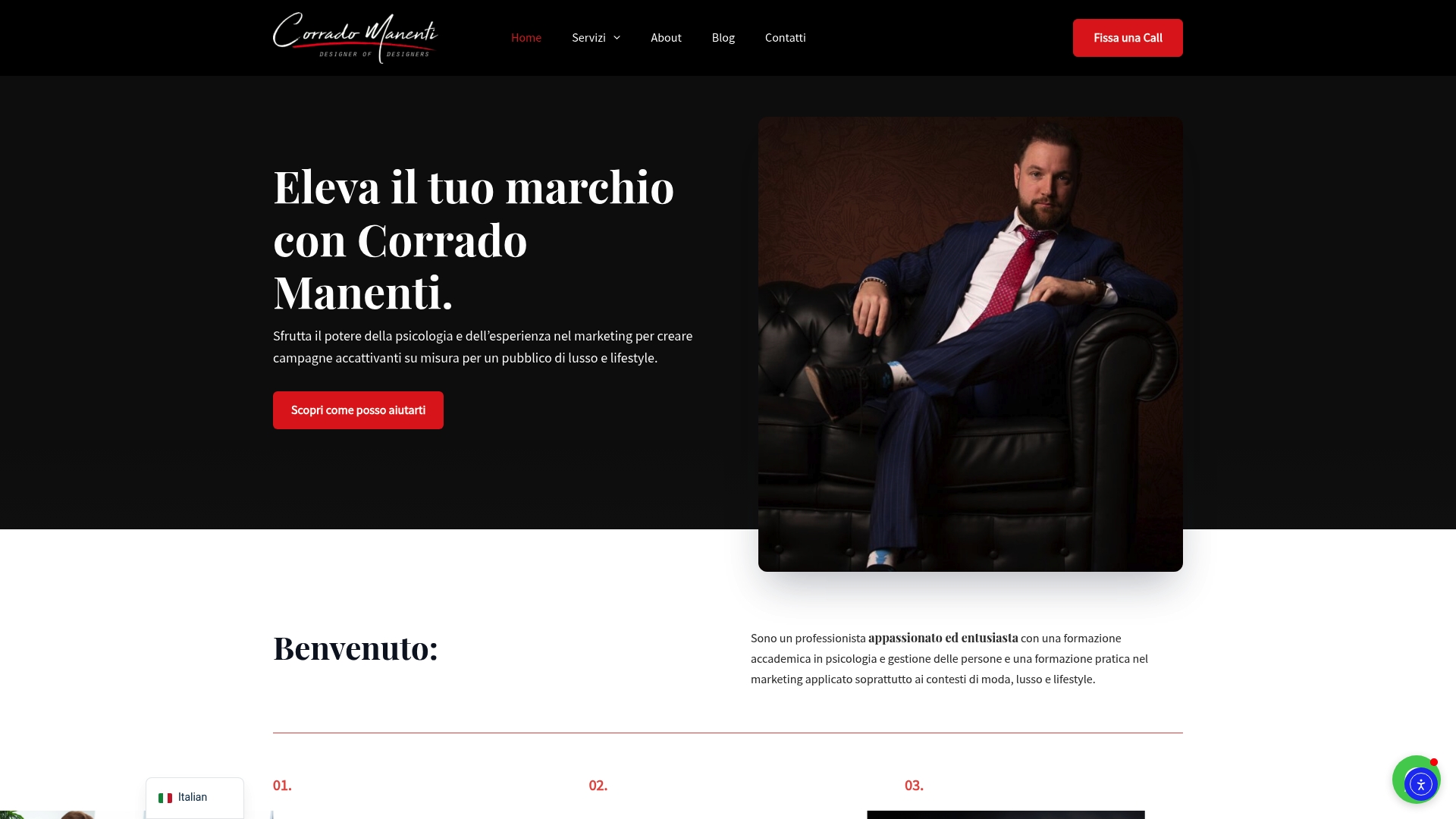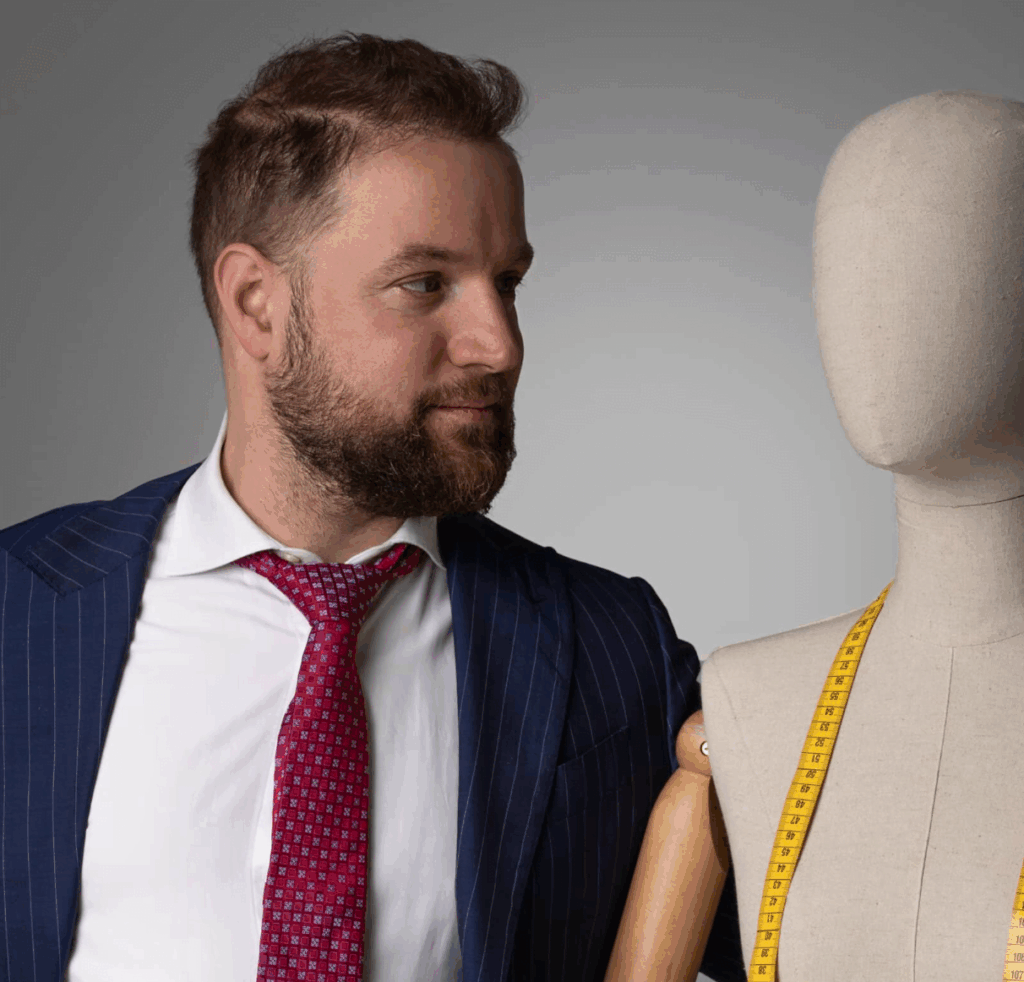Luxury brands spend millions trying to decode what drives their customers. Still, even the most sophisticated teams often miss the mark. Here’s a shocker: brands using advanced consumer behavior analysis have seen up to a 30% increase in customer retention. The real secret is not in big data or expensive tech but in how clearly you define your goals—and that single step can transform your entire strategy.
Table of Contents
- Step 1: Define Your Objectives And Kpis
- Step 2: Gather And Analyze Consumer Data
- Step 3: Segment Your Target Audience Effectively
- Step 4: Develop Behavioral Insights And Trends
- Step 5: Implement Tailored Marketing Strategies
- Step 6: Evaluate Outcomes And Adjust Strategies
Quick Summary
| Key Point | Explanation |
|---|---|
| 1. Define SMART objectives | Establish clear, specific objectives that are measurable, achievable, relevant, and time-bound to guide your analysis effectively. |
| 2. Gather high-quality data | Collect comprehensive, accurate data from multiple touchpoints to gain a complete understanding of your customers. |
| 3. Segment audience based on behaviors | Move beyond demographics to create nuanced customer segments based on behavioral and psychographic characteristics. |
| 4. Develop emotional insights | Analyze emotional triggers and motivations to understand the deeper reasons behind consumer purchasing behaviors. |
| 5. Implement responsive marketing strategies | Tailor your marketing efforts with personalized, emotionally resonant communications that address individual customer needs. |
Step 1: Define Your Objectives and KPIs
Successful consumer behavior analysis requires crystal clear objectives and precisely defined key performance indicators. Luxury brands must transform vague intentions into measurable strategic goals that provide actionable insights into customer psychology and purchasing patterns.
Establishing robust objectives begins with understanding the specific questions your consumer behavior analysis workflow aims to answer. Are you seeking to comprehend purchasing motivations? Track customer segmentation nuances? Predict future luxury market trends? Each objective demands a unique analytical approach and corresponding set of key metrics.
Start by conducting an internal strategic workshop with cross functional teams. Invite representatives from marketing, sales, customer experience, and product development to collaboratively outline your most pressing consumer insights needs. During this session, map out the precise information gaps that currently limit your brand’s understanding of customer behavior.
When defining objectives, focus on creating SMART goals: Specific, Measurable, Achievable, Relevant, and Time Bound. For example, instead of a vague goal like “understand customer preferences,” craft a precise objective such as “Identify the top three purchase drivers for our high net worth clientele within the next quarter, with a minimum statistical confidence of 85%.”
Key performance indicators should directly connect to these objectives. Recommended KPIs for luxury brand consumer behavior analysis might include:
- Customer lifetime value
- Purchase frequency
- Average transaction value
- Conversion rates across different marketing channels
- Customer retention percentages
Utilize advanced analytics platforms like Google Analytics or specialized luxury market research tools to track these metrics comprehensively. Select tools that offer granular segmentation capabilities and integrate seamlessly with your existing customer relationship management systems.
Below is a summary table of recommended KPIs for luxury brand consumer behavior analysis, including what each KPI measures and how it informs strategic decisions.
| KPI | What It Measures | Strategic Value |
|---|---|---|
| Customer lifetime value | Total value a customer brings over time | Identifies most valuable segments and guides retention efforts |
| Purchase frequency | How often customers buy | Reveals engagement trends and loyalty |
| Average transaction value | Average amount spent per purchase | Indicates spending power and helps refine upselling strategies |
| Conversion rates across channels | Percentage of users who complete desired actions | Shows which channels and messages drive actions |
| Customer retention percentage | Rate at which customers return | Measures loyalty and the effectiveness of retention strategies |
Successful objective setting requires continuous refinement. Schedule quarterly reviews to assess whether your current KPIs genuinely reflect emerging market dynamics and evolving customer expectations. Remain adaptable and willing to recalibrate your analytical approach as new insights emerge.
Verification of this step involves creating a documented objective framework that clearly outlines your consumer behavior analysis goals, associated KPIs, measurement methodologies, and expected outcomes. This document will serve as a strategic roadmap guiding your entire analytical workflow.

Step 2: Gather and Analyze Consumer Data
Data collection represents the critical foundation of an effective consumer behavior analysis workflow for luxury brands. This step transforms strategic objectives into tangible insights by systematically capturing and interpreting customer information across multiple touchpoints.
Begin by identifying comprehensive data sources that provide holistic customer perspectives. These should encompass digital interactions, direct customer feedback, transactional records, and behavioral patterns. Digital platforms like customer relationship management systems, website analytics, social media engagement metrics, and loyalty program databases offer rich information reservoirs.
Multichannel data collection becomes paramount in luxury markets where customer journeys are complex and nonlinear. Integrate data from physical retail experiences, digital platforms, customer service interactions, and exclusive events to create a 360 degree view of customer behavior. Modern luxury consumers seamlessly navigate between online and offline environments, demanding sophisticated data integration strategies.
Quality matters exponentially more than quantity. Prioritize gathering high fidelity data points that offer meaningful insights into customer motivations, preferences, and purchasing psychology. Implement robust data validation protocols to ensure information accuracy and eliminate potential biases or inconsistencies.
Utilize advanced analytics platforms that specialize in customer segmentation and behavioral analysis. Tools like Qubit provide sophisticated customer data platforms capable of processing complex luxury market datasets. These platforms can help transform raw data into actionable strategic intelligence.
Consider implementing the following data collection strategies:
- Develop comprehensive customer surveys with nuanced questioning techniques
- Leverage advanced tracking technologies in physical and digital retail environments
- Implement machine learning algorithms for predictive behavioral modeling
- Create personalized customer feedback mechanisms across multiple interaction points
Ethical data collection remains crucial. Ensure full compliance with international privacy regulations like GDPR and maintain transparent communication with customers about data usage. Build trust by demonstrating responsible and respectful data handling practices.
Successful data gathering requires continuous refinement. Regularly audit your data collection processes, update tracking methodologies, and remain adaptable to emerging consumer behavior trends. Verification of this step involves creating a comprehensive data inventory that maps collected information against your originally defined objectives, demonstrating clear alignment and potential insights generation.
Remember that data collection is not merely a technical exercise but a strategic opportunity to deeply understand your luxury brand’s most valuable asset: your customers.
Step 3: Segment Your Target Audience Effectively
Audience segmentation transforms raw customer data into strategic insights, enabling luxury brands to craft precisely targeted experiences that resonate with distinct customer groups. This critical step moves beyond generic demographic categorizations, diving deep into behavioral, psychographic, and emotional characteristics that define luxury consumer motivations.
Advanced segmentation transcends traditional market research approaches. Instead of relying solely on age, income, or geographic markers, modern luxury brands must construct multidimensional customer profiles that capture nuanced behavioral patterns, lifestyle preferences, and emotional drivers of purchasing decisions.
Begin by mapping your collected data against sophisticated segmentation frameworks. Look beyond surface level characteristics and explore the underlying psychological motivations that distinguish different customer groups. A high net worth individual purchasing a luxury watch might be driven by status signaling, personal craftsmanship appreciation, or investment potential.
Utilize advanced analytics platforms that offer machine learning capabilities for dynamic customer segmentation. Tools like Segment provide powerful customer data platforms capable of creating complex, evolving audience profiles that adapt to changing consumer behaviors.
Consider implementing segmentation criteria that capture the following dimensions:
- Psychological purchasing motivations
- Lifestyle and aspirational preferences
- Digital engagement patterns
- Brand interaction frequency
- Emotional connection to luxury experiences
Develop detailed customer personas that go beyond statistical representations. Each segment should tell a compelling narrative about customer expectations, communication preferences, and potential engagement strategies. For instance, a “Tech Savvy Luxury Minimalist” segment might require different marketing approaches compared to a “Classic Heritage Enthusiast” segment.
Personalization becomes the key differentiator in luxury market segmentation. Your goal is not merely to categorize customers but to create tailored experiences that feel individually crafted. This requires continuous refinement of segmentation strategies, integrating real time feedback and emerging consumer trends.
Implement a dynamic segmentation model that allows for fluid customer movement between categories. Luxury consumers are not static entities but evolving individuals whose preferences and motivations transform over time.
Verification of effective audience segmentation involves creating comprehensive segment profiles that demonstrate clear distinctions in behavior, preferences, and potential brand interactions. These profiles should provide actionable insights that directly inform marketing, product development, and customer experience strategies.
This table gives an overview of advanced segmentation criteria for luxury brands, illustrating dimensions and their influence on personalization and marketing.
| Segmentation Dimension | Description | Impact on Personalization |
|---|---|---|
| Psychological motivations | Underlying reasons for purchasing decisions | Enables messaging that aligns with customer values |
| Lifestyle preferences | Hobbies, interests, and daily habits | Helps craft relevant product recommendations |
| Digital engagement patterns | How, when, and where customers interact online | Optimizes channel selection and timing |
| Brand interaction frequency | How often the customer engages with your brand | Allows for tailored loyalty offers |
| Emotional connection | Level of attachment and sentiment toward brand | Guides storytelling and relationship-building efforts |
Remember that successful segmentation is an ongoing process of discovery, requiring continuous learning and adaptation to the complex landscape of luxury consumer behavior.
Step 4: Develop Behavioral Insights and Trends
Behavioral insights represent the crucial translation of raw data into strategic understanding, enabling luxury brands to anticipate and influence customer decisions with unprecedented precision. This step transforms statistical information into actionable narrative intelligence that reveals the deeper psychological motivations driving luxury consumption.
Advanced behavioral analysis goes beyond surface level observations, diving into the complex emotional and cognitive processes that shape purchasing decisions. Luxury consumers are not merely buying products but investing in experiences, status representations, and personal identity narratives.
Utilize sophisticated predictive analytics techniques to uncover emerging trends and potential future behavioral patterns. Machine learning algorithms can help identify subtle correlations and anticipatory signals that traditional research methods might overlook. By analyzing vast datasets, brands can predict shifts in consumer preferences before they become mainstream market trends.
Employ mixed methodology approaches that combine quantitative data analysis with qualitative research techniques. Statistical modeling provides objective insights, while narrative research methods like in depth interviews and ethnographic studies reveal the nuanced emotional landscapes driving luxury consumption.
Consider exploring behavioral insights across multiple dimensions:
- Emotional purchasing triggers
- Digital interaction patterns
- Cross channel engagement preferences
- Status signaling motivations
- Experiential value perceptions
Leverage advanced analytics platforms like Mixpanel that offer sophisticated behavioral tracking and predictive modeling capabilities. These tools can transform complex datasets into comprehensible visual narratives that highlight emerging consumer trends.
Context becomes paramount in behavioral trend analysis. Luxury brands must understand that consumer behaviors are deeply interconnected with broader social, technological, and cultural shifts. A comprehensive behavioral insights strategy requires continuous monitoring of external environmental factors that might influence consumer psychology.
Develop dynamic trend interpretation frameworks that allow for rapid adaptation. The luxury market moves at an accelerated pace, with consumer preferences evolving faster than traditional research methodologies can typically track. Create agile processes that enable quick hypothesis testing and trend validation.
Implement a systematic approach to trend documentation that captures not just statistical data but the underlying narratives and emotional contexts driving behavioral shifts. Each trend should be accompanied by potential strategic implications for product development, marketing communication, and customer experience design.
Verification of successful behavioral insights development involves creating comprehensive trend reports that demonstrate clear connections between collected data, identified patterns, and potential strategic actions. These reports should provide a forward looking perspective that enables proactive decision making rather than reactive responses.
Remember that behavioral insights are living, breathing narratives that require continuous cultivation and nuanced interpretation.
Step 5: Implement Tailored Marketing Strategies
Tailored marketing strategies transform consumer behavior insights into precision targeted engagement experiences that resonate deeply with luxury brand audiences. This critical step moves beyond generic communication approaches, creating personalized narratives that speak directly to individual customer segments and their unique psychological motivations.
Personalization becomes the cornerstone of modern luxury marketing, requiring brands to craft experiences that feel individually curated rather than mass produced. Each marketing touchpoint should reflect the specific emotional and aspirational drivers identified through your previous consumer behavior analysis workflow.
Develop a multichannel strategic approach that seamlessly integrates digital and physical brand interactions. Luxury consumers expect fluid, consistent experiences across platforms, demanding sophisticated communication strategies that adapt to their preferred engagement methods. This might involve creating unique content for different customer segments, utilizing personalized digital communication channels, and designing bespoke offline experiences.
Understand why microtargeting in luxury matters by implementing advanced segmentation techniques that allow for hyperspecific messaging. Machine learning algorithms can help predict individual customer preferences, enabling brands to deliver precisely targeted communications that feel intimately relevant.
Consider implementing marketing strategies across multiple engagement dimensions:
- Personalized digital content experiences
- Exclusive event invitations
- Customized product recommendations
- Tailored communication frequencies
- Emotionally resonant storytelling approaches
Utilize advanced marketing automation platforms like Klaviyo that offer sophisticated segmentation and personalization capabilities. These tools enable brands to create dynamic, responsive marketing experiences that adapt in real time to customer interactions and preferences.
Emotional storytelling becomes a critical marketing strategy in luxury markets. Move beyond product features to create narrative experiences that connect with customers psychological and aspirational dimensions. Each marketing communication should feel like an invitation into an exclusive world rather than a transactional pitch.
Develop agile marketing frameworks that allow continuous refinement based on customer feedback and emerging behavioral trends. The most effective luxury marketing strategies remain fluid, capable of rapid adaptation to changing consumer expectations.
Verification of successful marketing strategy implementation involves tracking engagement metrics across different customer segments, measuring the resonance of personalized experiences, and documenting the emotional and behavioral shifts triggered by your targeted approach.
Remember that tailored marketing is an ongoing dialogue, not a monologue. The most successful luxury brands create experiences that make customers feel uniquely understood and valued.

Step 6: Evaluate Outcomes and Adjust Strategies
Outcome evaluation represents the critical final phase of the consumer behavior analysis workflow, transforming collected insights into continuous strategic refinement. This step ensures that luxury brands maintain a dynamic, responsive approach to understanding and engaging their customer base, moving beyond static analysis towards adaptive intelligence.
Performance measurement requires a holistic and nuanced perspective that goes beyond simple numerical metrics. Luxury brands must develop comprehensive evaluation frameworks that capture both quantitative performance indicators and qualitative emotional engagement signals. This approach recognizes that customer relationships are complex, multidimensional experiences that cannot be reduced to singular data points.
Implement a robust analytics infrastructure that enables real time performance tracking across multiple dimensions. Advanced business intelligence platforms can help aggregate data from various sources, providing a comprehensive view of strategy effectiveness. Look beyond traditional conversion metrics to explore deeper engagement indicators such as brand sentiment, customer lifetime value, and emotional resonance.
Utilize advanced analytics tools like Google Analytics that offer sophisticated tracking capabilities. These platforms can help luxury brands understand the intricate pathways customers navigate through digital and physical brand interactions, revealing subtle behavioral patterns that might otherwise remain undetected.
Consider evaluating outcomes across the following strategic dimensions:
- Customer acquisition cost
- Emotional engagement metrics
- Brand perception shifts
- Conversion rate variations
- Customer retention percentages
Develop a culture of continuous learning and strategic adaptation. The most successful luxury brands view outcome evaluation not as a periodic audit but as an ongoing dialogue with their customer base. This requires creating flexible organizational structures that can rapidly interpret insights and implement strategic adjustments.
Predictive modeling becomes increasingly crucial in strategic refinement. Machine learning algorithms can help forecast potential future behavioral trends, enabling brands to proactively adjust their approaches before market shifts become fully apparent. This forward looking perspective transforms outcome evaluation from a retrospective exercise into a strategic forecasting tool.
Create comprehensive performance dashboards that provide clear, visual representations of strategy effectiveness. These dashboards should integrate multiple data sources, offering a holistic view of brand performance across different customer segments and engagement channels.
Verification of successful outcome evaluation involves documenting strategic insights, mapping observed behaviors against original objectives, and developing clear action plans for continuous improvement. The most effective luxury brands treat their consumer behavior analysis workflow as a living, evolving system of intelligence.
Remember that true strategic excellence emerges not from perfect initial execution but from continuous, humble learning and adaptive refinement.
Ready to Make Your Luxury Consumer Insights Work for You?
You now know that optimizing consumer behavior analysis takes more than gathering data. Setting SMART goals, digging into psychological motivators, and building tailored marketing strategies all require a deep understanding of the luxury audience. But these challenges—like creating real behavioral segmentation or translating analytics into meaningful action—often leave brands stuck with generic campaigns and missed opportunities.
If you want your consumer analysis to deliver the market advantage you need, discover how a psychology-driven approach can transform your results. Explore Marketing Mode to see how practical expertise and psychological insight can give your brand a lasting edge.

Take the next step toward smarter luxury marketing. Visit Corrado Manenti’s website for proven, detail-oriented strategies designed for the fashion and luxury sector. Secure your brand’s position as a leader in consumer understanding—let’s work together to turn insights into exceptional results.
Frequently Asked Questions
How do I define clear objectives for consumer behavior analysis in luxury brands?
Establish specific and measurable objectives by identifying key questions your analysis should answer, such as understanding purchasing motivations or tracking customer segmentation. Organize a workshop with cross-functional teams to collaboratively outline your objectives, ensuring they adhere to the SMART criteria.
What key performance indicators (KPIs) should I track for luxury brand consumer behavior analysis?
Key performance indicators for luxury brands include customer lifetime value, purchase frequency, and conversion rates across different marketing channels. Choose KPIs that align directly with your established objectives to measure effectiveness and adjust strategies accordingly.
How can I effectively gather and analyze consumer data for luxury brands?
Begin by collecting data from diverse sources like digital interactions and customer feedback to form a comprehensive view of customer behavior. Ensure data quality through validation protocols, and gather high-fidelity data points that offer rich insights into customer preferences and motivations.
What strategies can I use for effective audience segmentation in luxury markets?
Use advanced segmentation criteria that go beyond demographics to explore emotional drivers, lifestyle preferences, and digital engagement patterns. Develop detailed customer personas based on your analysis to identify unique expectations and tailor experiences that resonate with each segment.
How can I implement tailored marketing strategies based on consumer behavior insights?
Create personalized marketing campaigns that reflect the emotional and aspirational drivers of your target segments. Develop a multichannel approach that adapts to various engagement preferences, utilizing techniques like bespoke offline experiences and customized digital content.
What steps should I take to evaluate outcomes and adjust my strategies in consumer behavior analysis?
Regularly assess your performance metrics holistically, including customer acquisition costs and emotional engagement metrics. Establish a culture of continuous learning by documenting your findings and using predictive modeling to proactively adapt your strategies ahead of market shifts.



